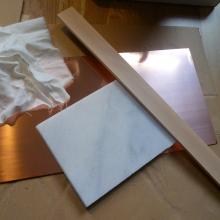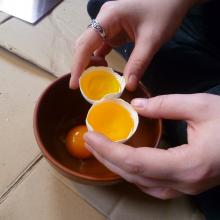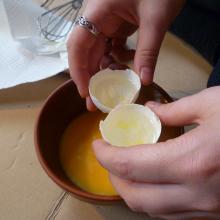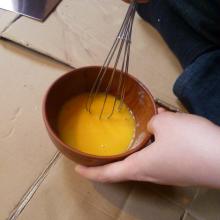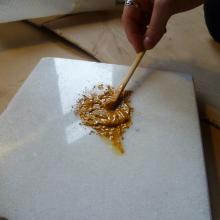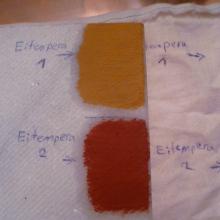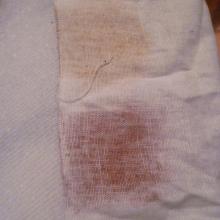For the exhibition Gods in Colour, where the Hetairoi will be present in December, we started to research historic paint. Together with Agnes Zankl from the society "Wienische Hantwërcliute 1350", I will conduct multiple experiments with earth pigments over the next weeks.
Earth pigments are basically nothing more than dried earth. Of course, most earths in nature are either brown or gray, but at certain places around the globe there are impressively colourful earths, like various yellow and gold colours, ochre, red, and even green earths. The earth is then dried for a long time and grinded to a powder. However, we skipped this stage conveniently and purchased earth pigments from a specialized trader. The coloured powder is then mixed with a base substance and applied to the surface with a brush or a scoop. Besides earth pigments, there are other pigments, which can in part be obtained from various alloys (e.g. Egyptian Blue, Lead Tin). However, the ancient formulae are sometimes a health hazard and so you have to use caution when working with them.
To test the resulting paints on various surfaces, we obtained the following objects:
- Marble Plate
- Wood
- Linen
- Copper Sheet
We were especially interested in the result on the linen fabric, because the paint needs to be very flexible here or else it will just crumble when the fabric is folded. The surface of the copper sheet, the wood, and the marble were sanded so they would accept the paint better.
For our first try, we used a so called egg tempera as the base substance. We got the recipe from the book Malmaterial by Max Doerner. We mixed a whole egg, linseed oil, and water in equal parts. The resulting yellow liquid can be mixed with the pigments to create a thick liquid paint.
First, the egg is given to a bowl, the linseed oil is mixed in afterwards. If you are careful enough while cracking the egg, you can use the empty egg shell as a measuring cup to get the perfect composition. The tempera is then stirred without the pigments and is now ready for use as a base substance.
The paint can then be applied with a brush just like a regular modern paint. The result varies strongly depending on the surface material. The colour worked perfectly on marble, wood and fabric, forming a beautiful layer of paint. The paint soaked in good enough after a drying period of approximately one day, so that we could not remove it any longer with our fingers. The paint on the marble plate quickly formed an oil rim around the painted area. This could be a sign that we used too much linseed oil for the tempera. The oil rim was noticable on the linen as well, but not as strong as on the marble. The colour on the linen really surprised us with its flexibility given by the egg tempera. You can even crumple the fabric without the colour coming off.
The copper sheet, unfortunately, shows a different result. The colour could easily be wiped off the surface using only our fingers after one day had passed. To paint metal, you apparently have to use some other base than egg tempera.
Addendum on 03/12/2012: after the paint dried out for several weeks, I discovered that I could no longer remove it from the copper sheet by rubbing or scratching it. It seems to work as well, just takes a little longer to dry out.
On our next try, we will use casein as the base substance. We expect quite different results from it regarding the flexibility and the result on marble.



